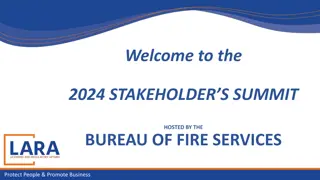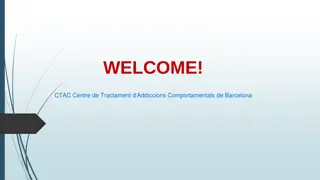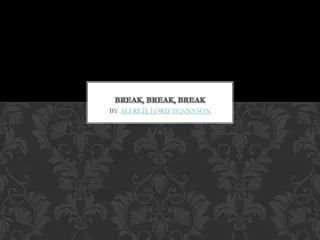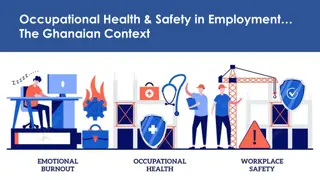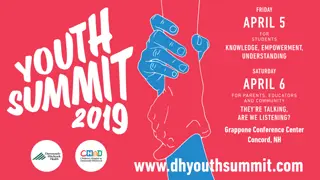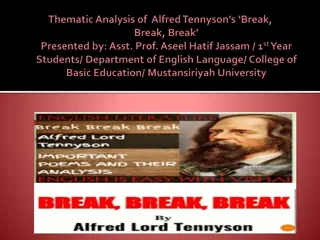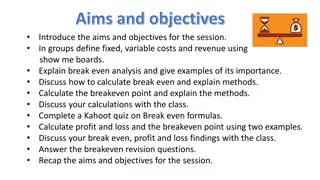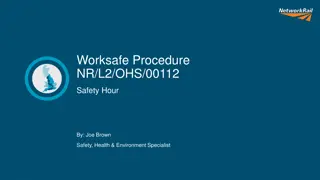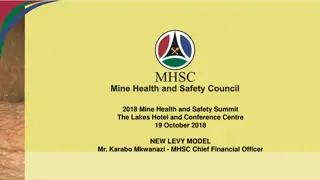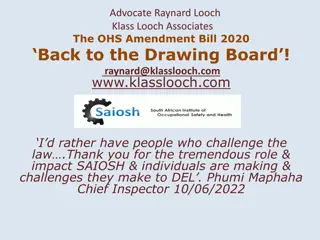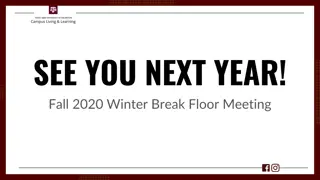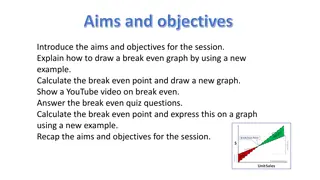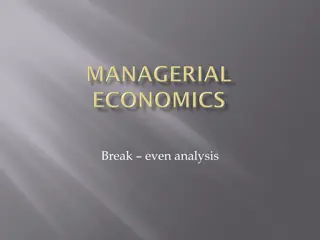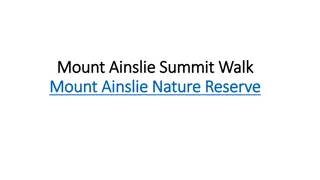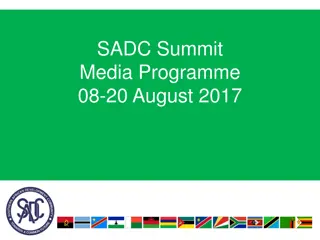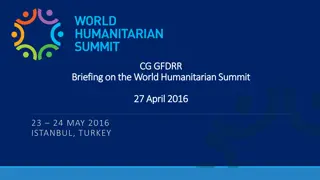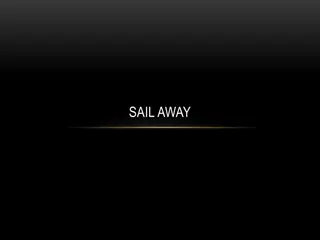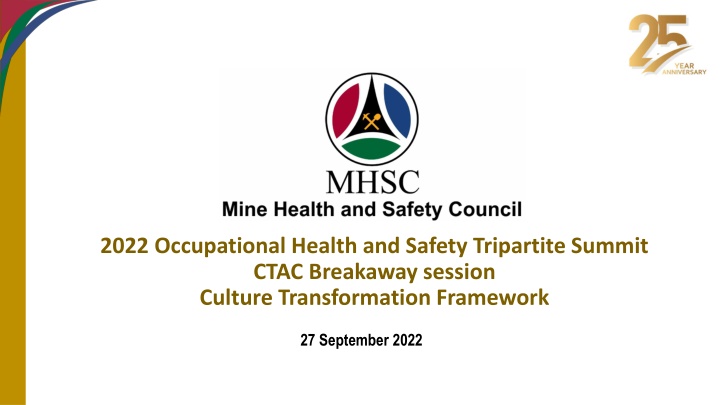
Culture Transformation Framework in Occupational Health and Safety Summit
The Culture Transformation Framework (CTF) in Occupational Health and Safety (OHS) has been a key focus in summits over the years, aiming to accelerate the journey to Zero Harm. Stakeholders collaborated to develop milestones and pillars within the CTF, addressing human behavior factors impacting OHS culture. Stakeholders agreed to implement specific pillars by set timelines, emphasizing leadership, risk management, diversity management, leading practices, and data management. This framework seeks to drive industry-wide adoption of best practices and research outcomes in pursuit of Zero Harm.
Uploaded on | 1 Views
Download Presentation

Please find below an Image/Link to download the presentation.
The content on the website is provided AS IS for your information and personal use only. It may not be sold, licensed, or shared on other websites without obtaining consent from the author. If you encounter any issues during the download, it is possible that the publisher has removed the file from their server.
You are allowed to download the files provided on this website for personal or commercial use, subject to the condition that they are used lawfully. All files are the property of their respective owners.
The content on the website is provided AS IS for your information and personal use only. It may not be sold, licensed, or shared on other websites without obtaining consent from the author.
E N D
Presentation Transcript
2022 Occupational Health and Safety Tripartite Summit CTAC Breakaway session Culture Transformation Framework 27 September 2022
BACKGROUND 2014 SUMMIT MILESTONES: The milestones were developed collaboratively by the stakeholders to accelerate the journey to Zero Harm and were agreed upon by the SAMI Principals. In 2008 Changing Mines and Changing Minds project commissioned. The SAMI had focused on engineering systems, neglecting human behavior factors impacting on OHS. The outcomes of the study led to the development of the CTF, with thirteen (13) pillars which were meant to address human behavior and envisaged to change the OHS culture The CTF was the launched at the 2011 OHS summit. Upon further deliberations, the pillars were collapsed into eleven (11) in 2014 Stakeholders agreed to implement only 5 until December 2020 and the remainder by 2024 25 years in Pursuit of Zero Harm
2014 SUMMIT MILESTONES:. Eleven CTF pillars were developed in the OHS Summit held in 2014 and the MHSC stakeholders agreed to implement six of the pillars, namely: Integrated Mining Activities, Technology, Tripartism, Inspectorate, Regulatory Framework, Leadership, Risk Management, Bonuses and Performance Incentives, Leading Practices, Elimination of Discrimination (Diversity Management) and Data Management. The stakeholders agreed on implementing five of the pillars by December 2020 and the remaining five pillars were then agreed to be implemented by Dec 2024. The tripartite principal stakeholders however agreed at the 2016 Tripartite Summit, that the CTF implementation should be extended to the year 2020 on the basis that the majority of companies had not implemented all the five pillars 100%. A number of companies constantly indicated to the MHSC the need for guidance on the implementation of the CTF. Each milestone has clear initiatives, action plans, timeframes, roles & responsibilities as well as the implementation of critical activities such as Adoption of leading practices & Implementation of research outcomes. 25 years in Pursuit of Zero Harm
PRIORITISED CTF PILLARS (SIX PILLARS) PILLAR INTENTION That our leaders will lead by example in walking the Zero Harm talk. RESPONSIBILITY All Stakeholders 1. LEADERSHIP* Individual Mines Holding Companies Mineral s Council of South Africa Government We will seek to eliminate risks at their source and Investigate the root causes of incidents. 2. RISK MANAGEMENT* Holding Companies Organised Labour Mineral s Council of South Africa We will ensure that Zero Harm is prioritised ahead of Production. 3. BONUSES AND PERFORMANCE INCENTIVES* Individual Mines Holding Companies Mineral s Council of South Africa Government There will be no racism, genderism and any forms of unfair discrimination. 4. DIVERSITY MANAGEMENT* We will take a common approach to identifying and facilitating the adoption of leading OHS practices and research outcomes. We will establish a data system that allows effective and timely collection, capture, analysis, communication, dissemination and use by the industry of mine Health and Safety information. Mineral s Council of South Africa Government Mine Health and Safety Council 5. LEADING PRACTICE* Government Mine Health and Safety Council 6. DATA MANAGEMENT* 25 years in Pursuit of Zero Harm
ALL PILLARS CULTURE TRANSFORMATION FRAMEWORK REMAINING CTF PILLARS THAT WERE DUE FOR IMPLEMENTATION 2024 We will base mining activities on the recognition that health, safety and production are not competing objectives. Safety and health are the outcomes of work well done. Individual Mines Holding Companies Mineral s Council of South Africa Individual Mines 7. INTEGRATED MINING ACTIVITIES Holding Companies Mineral s Council of South Africa Mine Health and Safety Council 8. TECHNOLOGY We will adopt mechanisation and technology as a key method of eliminating health and safety risks to mine employees. Government Government, Labour and Employers will regularly engage to pursue common objectives and goals for the mining industry. We will develop clear, concise and understandable legislation that includes enforceable minimum standards. 9. TRIPARTISM ALL Stakeholders 10. REGULATORY FRAMEWORK Mine Health and Safety Council We will create an effective, well-resourced inspectorate that can protect people at and around mines with integrity and job pride. 11. INSPECTORATE Government 25 years in Pursuit of Zero Harm
CHALLENGES THAT WERE BROUGHT UP IN THE 2018 SUMMIT. CHALLENGE RESOLUTION 1. Momentum for transformation has been lost. 2. Transformation actions are compliance based 3. Leaders expect things to happen without being explicit and transparent about what they want. 4. Leaders are not trained to make decisions around technology. 5. Historically, mining does not have a culture of executive liability. 6. Reactive approach to health and safety, not proactive 7. Leaders are not transformed and hence subordinates cannot be transformed 25 years in Pursuit of Zero Harm
CHALLENGES THAT WERE BROUGHT UP IN THE 2018 SUMMIT CHALLENGE RESOLUTION 8. Leaders are not transformed and hence subordinates cannot be transformed 9. Language used in terms of leadership absolves workers of the responsibility of their own safety as they don t see themselves as leaders. 10. Are we reducing the risk? A state of complacency! 11. Leaders must address victimisation and discrimination. 12. Trade unions relations. 13. Leaders must define who they are and what they stand for. 14. Trade unions differences a need to collaborate for the interest of workers. 25 years in Pursuit of Zero Harm
What are additional challenges? How do we address these collectively Are the recommended actions for the existing challenges enough 25 years in Pursuit of Zero Harm
CTF Initiatives from 2018 Summit and progress 2018 CTF Initiatives Initiative Question Answer By December 2020: 100% implementation of the Leadership, Risk Management, Data Management, Diversity Management, Leading Practice and Bonus and Performance Incentive pillars. Beyond 2020:Implementation of the Integrated Mining Activity, Technology, Inspectorate, Tripartism, Regulatory Framework Activities: 2018 CTF Activities Progress Initiative Guidelines and adoption of leading practices Popularisation of pillars Develop and implement WIM and Right of workers programs Development of MRP 25 years in Pursuit of Zero Harm
CTF Initiatives from 2018 Summit and progress Equip leaders to understand the implications of technology decisions in making the working environment safer and healthier. Use Regional Tripartite Forums as a platform to drive cultural transformation and mine health and safety days Design, implement and popularize guidelines containing minimum standards for all CTF Pillars Coach industry leaders to move to a point where people understand culture transformation as a business imperative, not for compliance Review Bonus system to ensure that reps prioritise health and safety Improve tripartite relationship between government, labour and the employer MHSC to work with MQA to develop a programme to enhance the skills set identified for the SAMI 70-100% Accountability measures must be put in place in order to begin to inculcate a culture that is enabling to the guidelines of Right to Refuse Dangerous Work (RRDW) and Right to Refuse Dangerous Work (RRDWL). CTF Expedite 25-69% Training and awareness of employees on major health and safety hazards Provide knowledge to strengthen knowledge of MOSH leading practices to empower employees through their representatives <25% Convene countrywide workshops focusing on the RRDW and RDWP. Conduct an impact assessment on the implementation of the guidelines of RRDW and RLDWP. 25 years in Pursuit of Zero Harm
How far have we progressed since the 2018 summit with the challenges? Progression graphs from 2014-2020 Graph pillar per commodity, per year, per region, entire industry 25 years in Pursuit of Zero Harm
Problem statement Decision regarding implementing new 5 pillars are we ready or do we need to focus on the existing 5 pillars How do we move forward to improve the results For each pillar Improving reporting What are some of the impediments to achieving 100% etc 25 years in Pursuit of Zero Harm
How do we move forward to improve the results For each pillar Culture Assessment July 2021 November 2021 January - end October 2022 November 2022 Data Analysis and Reporting Project Mobilisation Survey Interviews Desktop Review Process: Launch data collection tool to individuals from pilot mines. Process: Conduct interviews with key industry tripartite stakeholders. Process: A integrated report highlighting key themes, successes and barriers to shifting the culture of health and safety across the mining industry. . Our Ask: Assist in encouraging the mines to complete the survey. We have 30 out of 500 responses. Our Ask: If you have been nominated by MHSC, look out for emails from PwC to set up a session. Survey close: End October 2022 25 years in Pursuit of Zero Harm
How do we move forward to improve the results For each pillar Bonuses and Performance Incentives Elimination of Discrimination Leading Practice Risk Management Leadership Discussion points: Discussion points: Discussion points: Discussion points: Discussion points: - To what extent have leading practices for Zero Harm been adopted across the mining industry? - Has there been a shift in the culture of Leadership walking the Zero harm talk? - Has there been a shift in the management of risks associated with health and safety across the mining industry? - To what extent has a culture of diversity and inclusion been created across the mining industry? - Has there been a shift in the culture of reward and recognition for good behaviours associated with health and safety? - Share some examples of what Leaders are doing to show their commitment and role model the right behaviours? - Are there pockets of good behaviour where mines are getting it right? Examples and enablers - Are there pockets of good behaviour where mines are getting it right? Examples and enablers - Are there pockets of good behaviour where mines are role modelling the right behaviours? Examples and enablers - Share some examples of informal and formal ways that mines are recognising the right behaviours? - What are some of the challenges / barriers to creating a safety culture aligned to leading practice? - What barriers inhibit us from shifting the culture of effective risk management across the mines? - What is holding Leadership back from showing up differently to shift the culture of health and safety? - What are some of the challenges / barriers to creating a safe environment free of discrimintaion? - What are some of the challenges / barriers to rewarding and recognising health and safety behaviours? 25 years in Pursuit of Zero Harm
How do we move forward to Improving reporting CHALLENGES RECOMMENDED ACTIONS Small mines do not understand the pillars. A guidance note was uploaded on the portal and it did not help and they recommended regional active workshops. 2. Quarterly reports on the 2014 Milestones Quarterly progress report back and not only when its time for summit. 3. An audit tool A request for an audit tool document and to be loaded on the portal. The appointment of the service provider duration should be linked to the next summit going forward. 4.System uptime The request is that the mines be given another year to implement the current pillars. 5.Way forward on the implementation of the next five pillars. 25 years in Pursuit of Zero Harm
How do we move on the current initiatives and do we need additional? Do we continue pursuing the additional 5 initiatives

